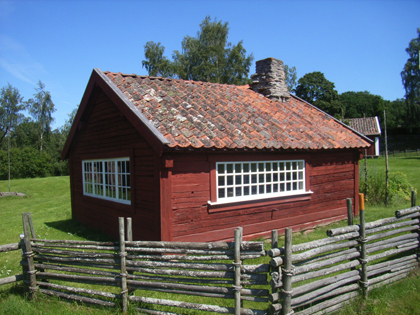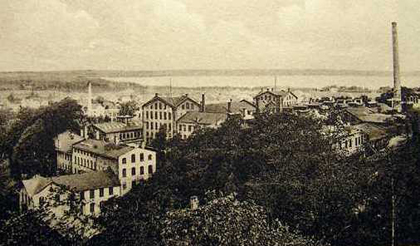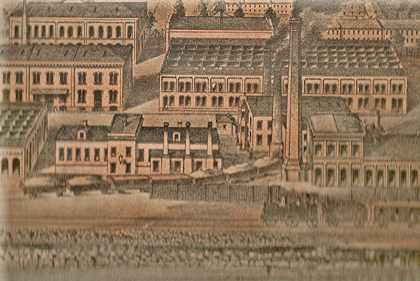Anders Gustafsson and family
The Aledal Key Factory was founded by armorer Anders Johan Gustafsson, born in Bankeryd in 1827. His father was master pistolsmith Anders Gustafsson, who was born in Habo in 1801 and who married the daughter of a recently deceased master locksmith from Granshults Östergård farm, at the age of 25. Through this union, Anders Gustafsson took over the factory and the estate from his mother-in-law and started supplying weapon components to the Husqvarna Faktori rifle factory from the smithy. Husqvarna is a manufacturing town just north of Jönköping.
The family lived in Östergården until 1844, when they made the daring move, with their seven young children, to the artisan town of Carl Gustafs Stad near Eskilstuna. Anders Gustafsson had been offered work at the Kronogevärsfaktori (Royal Rifle Factory).
 |
| A forge, moved from Granshult to the Bankeryd folk museum in 1955. Photo by the author. |
Carl Gustafs Stad was a whole community of artisans surrounding the hardware manufacturing industry established by Reinhold Rademacher (1609–1668) on order of King Carl X Gustaf in 1656. This workshop community marked the origins of Eskilstuna industry. By 1812, the Crown had acquired all that remained of Carl Gustafs Stad, and in the late 1830’s a factory was opened that in just ten years had over 100 employees and a production capacity of 2,000 infantry rifles a year.
Anders Johan Gustafsson
It was thus natural for Anders Gustafsson’s sons to learn the trade, and his eldest child, Anders Johan, followed in his father’s footsteps. At the young age of 23, after graduating in Stockholm with an elementary engineering degree, he was employed as Crown Armorer at Carl Gustafs Kronogevärsfaktori. Being an armorer required impassioned gunsmithing skills as well as a sharp eye, as the job also involved checking and stamping each approved rifle as one of two official inspectors.
Modern forging methods from the USA and the continent reached Sweden in the early 1840s through machinist Theofron Munktell. These methods, which included the use of drop forging and eccentric presses, were quickly put to use at the Carl Gustaf forges. Reorganization and new product lines had made this Sweden’s most modern factory, so Anders Johan was clearly in the right place at the right time to learn the latest techniques and methods. After three years at the factory, Anders Johan was ready to put his new skills to another, more lucrative, use.
In 1853, after a brief period working at the arsenal in Karlsborg, he returned to Småland and the Husqvarna Faktori, where he was given the same responsibilities as he had in Carl Gustafs Stad.
The Husqvarna Faktori
The Husqvarna Faktori had been stagnating since the early 1800s with years of unfilled order books. The factory and residential buildings fell into disrepair and the relatively rudimentary machinery that it owned became unusable. In 1849, however, the Ankarcrona family, with Theodor at its head, assumed power and control over the factory, made it into a corporation and gave it a new lease on life.
The Jönköping factory
The Husqvarna Faktori was preceded by the Jönköping factory, founded in 1620 by Gustav II Adolf as part of a nationwide armament industry, overseen by a foreman.
In fact, Småland farmers had a long history of making weapons for the Crown alongside their small-scale farming. For years, the Crown had tried, largely in vain, to unite these smiths in one factory in Jönköping. Their first plants were concentrated on the outskirts of town on the Dunkehallaån river, but gradually drilling workshops started to appear outside town, in Barnarp and by the Domneån river in Bankeryd.
Because of continual problems with the erratic supply of water power from the Dunkehallaån river, it was eventually decided to transfer parts of the factory to the city of Huskvarna (modern spelling of Husqvarna).
A powder mill, built in 1630, was already in place by the powerful Huskvarnaån river falls, and in 1689 it was joined by a drilling workshop that was planned and designed by the then county governor of Jönköping, Erik Dahlberg. He was also responsible for designing the layout of the artisan community’s administrative, industrial and residential buildings.
 |
| Huskvarna industries at the end of the 19th century. Postcard. |
Husqvarna Faktori became a competitor of the Carl Gustav factory
Back in Småland, Anders Johan helped to modernize the Husqvarna Faktori, in some areas at least, by replacing large parts of the manual manufacturing process with new machines. He also built his own machines and traveled to Germany, France and Belgium to learn about the manufacture of the successful new Remington rifles. In 1867, it was decided to make these firearms, which used metal cartridges instead of percussion locks, standard issue for the Swedish infantry. Anders Johan also purchased the machinery needed for the industrial manufacture of the Remington rifle. In the early 1870s, most machines were still water-powered. Up until 1871, Anders Johan was the de facto head of the Husqvarna Faktori along with a supervisor and accountants.
Jönköping becomes an industrial town
The 1870s were prosperous years, during which Jönköping gradually developed into an industrial town. A railway line was extended to the town and was officially opened, along with a new station house, by King Oscar II. A fancy central hotel had long stood at the ready in preparation for this. The brothers Johan Edvard and Carl Frans Lundström had started manufacturing matches in Jönköpings Tändsticksfabrik AB back in 1847; now this expanding company was under the control of Bernhard Hay, who had installed modern machines and was in the process of building more, and larger factories. Carl Frans founded the textile factory Strands Wäfveri, while his brother and politician Lars Johan Hierta started the Munksjö paper mill, which was run by Hierta. The two match brothers were also involved in the founding of Jönköpings Mekaniska Werkstad (“Jönköping’s Mechanical Workshop,” JMW) with Frans Gustaf Sandwall in 1859. At this time, JMW was being run by Sandwall in partnership with Claes Gustafsson. Other industries operating in Jönköping included the Sahlströmska dye works and Norlings wallpaper factory.
 |
| Part of Jönköpings Tändsticksfabrik AB in the 1870s. The single-story building in the foreground is now the matchstick museum. Lithograph. |